[Editor’s Note: Jason Apuzzo has decided to review Inception upside down. If you are unable to grasp the complex paradox this represents, it’s possible that you are simply a philistine.]
Posted on July 16th, 2010 at 11:43pm.
By David Ross. Pixar vs. Faux-Pixar is the duel at the local megaplex this summer, as Universal Studio’s Despicable Me and Dreamworks’ Megamind square off against Pixar’s Toy Story 3. In the end, there can be no real contest. Pixar is a genuine American classic, a creative serendipity feeding as directly and undeniably into the permanent culture as the Wright Brothers’ bicycle shop or Frank Lloyd Wright’s Taliesin West. Pixar’s few corporate peers are Levi’s, Winchester, Harley-Davidson, Topps, Fender – companies that have found forms somehow expressive of the national spirit. Pixar stands athwart the cynical, noisy, sexualized nonsense of the mall culture, and says, effectively, “None of this is necessary.”
Toy Story 3 is steeped in heart and soul and memory, with time itself – as in all the greatest works – somehow the nemesis. It arguably tops the previousToy Story installments and The Incredibles – masterpieces in their own right – and exemplifies as well as anything what American companies are capable of creating when they heed their better angels.
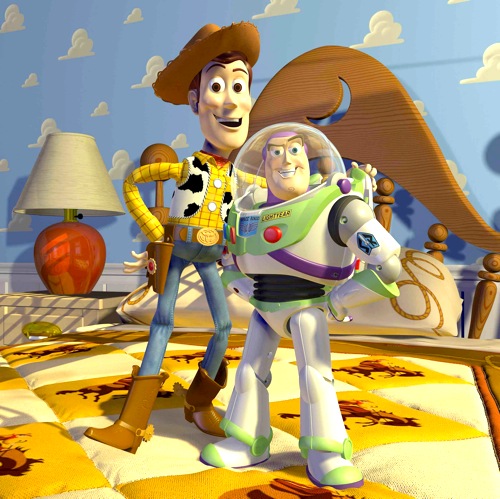
The story is simple enough. Andy is leaving for college. He’s decided to take Woody with him (a detail full of wonderful sentimental implication), while the rest of the gang are grumblingly headed to the attic in a garbage bag. A mix-up lands the bag at the curb with the rest of the trash. Led by Buzz Lightyear, the toys escape their polyethylene tomb, scamper into the family car, and climb into a box destined for the Sunnyside Daycare Center. This turns out to be a militarized police state run by an emotionally warped teddy bear named Lotso and his henchman (“Authority should derive from the consent of the governed, not from the threat of force!” declares Barbie, echoing Thomas Jefferson). Woody must, of course, save his friends and find his way home in time to depart with Andy. There ensues the mother of all prison-break sequences, a careening, antic homage to The Grand Illusion, Stalag 17, and Bresson’s A Man Escaped. It is certainly the first scene of its type to pivot on the availability of a tortilla, or to require the Scotch-taping of a cymbal-playing monkey. In the end, suffice it to say, the film affirms the values of friendship and loyalty; gracefully negotiates Andy’s passage to adulthood; and looks kindly on the cycling of the generations – the essence of cultural health – as Andy’s toys pass lovingly into younger hands.
Pixar never engages in the crass partisan whining of a film like Avatar (“shock and awe,” etc.), but each of Pixar’s films contains the gentlest and least intrusive suggestion of a guiding conservatism, it seems to me. The governing ideas are something like: 1) What was good then, is good now; 2) Each of us has duties that we must determine and fulfill; 3) Memory is the essence of our humanity; 4) Capitalism does not destroy, but creates culture – not necessarily a high culture, but a culture worth loving; 5) There are leaders and followers – natural, organic, unenforced hierarchies – and we must each assess and accept our place, 6) In time of trouble, the cowboy and spaceman – embodiments of the heroic aspiration I discussed here – will see us through. Toy Story 3 is, to my mind, precisely what a conservative film should be: a demonstration of certain virtues and laws of nature, which the wise can interpret and apply as they see fit.
The film has plenty of fun with the metrosexuality of Ken (doesn’t Mattel have lawyers?), but its more meaningful dig at the Blue State geist involves Lotso. Once a little girl’s beloved companion, he was accidentally left behind at a picnic in the countryside; he valiantly journeyed back to his house only to find that he had been replaced by another bear exactly like himself. In his heartbreak, he became bitter, cynical, alienated … as George W. Bush would say, evil.
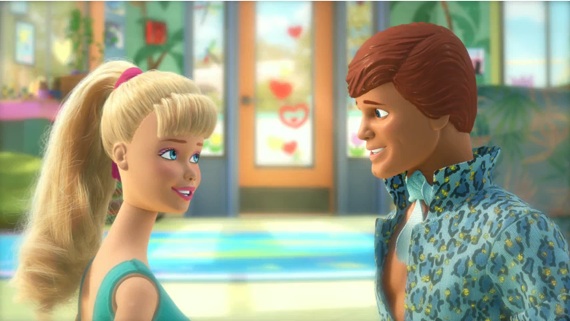
Your typical Hollywood simpletons would proceed as programmed to a trite conversion scene, on the assumption that all humans are essentially good and can be reclaimed with a hug. Pixar has no patience with touchy-feely delusions about human nature. The climax of the film finds the whole gang on a conveyor belt headed toward a pair of whirling metal teeth (the scene reverses the usual environmentalist fanfare of rainbows and dancing flowers; recycling has never been conceived so menacingly). Woody risks his life to free the trapped Lotso, and they narrowly avoid death by mastication. With the gang now headed toward a demonic abyss of fire, Woody points Lot-so toward a big red stop button. Woody assumes, just as we assume, that Lotso, having been touched by the magic wand of love, is now a good guy. But no! Without the least hesitation, Lotso sends the whole gang into the fiery maw of hell (rescue arrives from other quarters). The point seems to be that some people really are evil and we had best take their evil seriously. If only the proponents of the “Overseas Contingency Operation” and “Man-Caused Disasters” had the wisdom of Pixar!
As in all the Toy Story films, the periphery is rife with humor and delight. Notice a cameo appearance by Miyazaki’s Totoro in Bonnie’s bedroom. Thus one master celebrates another. I noticed too – and had to applaud – Bonnie’s outfit: plastic bead necklace, purple tutu, rain boots. My five-year-old daughter laughed; she understood well enough that these smart fellows had fixed her in their mirror.
Posted on July 16th, 2010 at 9:41am.

[Editor’s Note: “Despicable Me” dominated the weekend box office, taking in over $60 million.]
By Patricia Ducey. Gru’s archvillain mojo is beginning to fade – even his mom (Julie Andrews) calls to needle him when another, better, villain steals the Great Pyramid of Egypt. Even Gru’s usual evil misdeeds, like scaring his suburban neighbors, aren’t as much fun as they used to be. Somehow he has to concoct an even bigger heist to take back his title, so to speak – and gain his mother’s love?
In its first release, Universal’s family unit Illumination scores a solid hit with Despicable Me (directed by Pierre Coffin and Chris Renaud). Full of wit and heart and remarkably free of left-leaning messages (no cynicism, environmentalism or US bashing here), Despicable is actually quite lovable. (I quickly forgave the one stereotype of people from Alabama in an early scene, when they skewered Keith Olbermann in the next.) At 95 minutes, it’s just right for kids.
Gru (ably voiced by Steve Carell) decides to steal the Moon, using a Shrink Ray gun, but he needs venture capital to get the project, literally, off the ground. Aided by Dr. Nefario, in a hilarious turn by Russell Brand – and hundreds of tiny yellow, perhaps robot, minions (Grunions?) – he hatches a plan. Gru rallies his minions a la Steve Jobs, in a very funny scene only the adults will get.
At the “Bank of Evil (formerly Lehman Brothers),” though, loan officer Mr. Perkins is not impressed. Perkins dismisses Gru with a curt: “We’re going with somebody younger.” Later we learn that Perkins is actually funding his son Victor, now ‘Vector,’ as top villain after his triumphant swiping of the Pyramid.

If Gru can’t build a Shrink Ray, he will steal a Shrink Ray. After all, he is a villain. Gru decides to adopt three orphan girls who have managed to gain access to Vector’s lair by selling Vector his favorite cookies. But the best laid plans sometime go awry, and Gru finds himself falling for the delightful little girls instead. Continue reading New French Competition for Pixar? LFM Reviews Despicable Me

By Joe Bendel. According to filmmaker Landon Van Soest, $2.3 trillion (with a “t”) worth of western foreign aid has flowed into Africa over the last fifty years. What has been the result of these enormous outlays? Mostly ill-will and corruption according to the average Kenyans whose daily struggles Van Soest documents in Good Fortune, which airs this coming Tuesday on PBS’s POV.
UN program manager Sara Candiracci does not exactly have the common touch. The poverty of Nairobi’s Kibera slum personally offends her, which is laudable. Partnering with the Kenyan government, the UN is launching an ambitious redevelopment project for Kibera. However, she admits up front: “the strategy to move people and to bring them back is still not clear” – yet the residents should welcome the project anyway.
Kibera might be an eyesore to Candiracci, but it represents a better way of life for midwife Silva Adhiambo. Finding ample work there, she happily calls it home. In one telling scene, she perfectly illustrates why Kibera is so skeptical of the UN’s plans. The so-called slum is actually surrounded by three modern housing developments. One high-rise estate was billed as low income housing during construction, only to become home to well-connected government officials when completed. Another neighboring housing project remains unfinished due to litigation stemming from government embezzlement. A third development was allegedly built by Kenya’s First Lady with western aid money earmarked for AIDS programs – and then sold for a tidy profit. Indeed, having gone down this road before, the Kibera neighborhood is dead-set against the UN project, but Candiracci and the Kenyan government are not listening. Continue reading The Mixed Blessings of Foreign Aid: Good Fortune
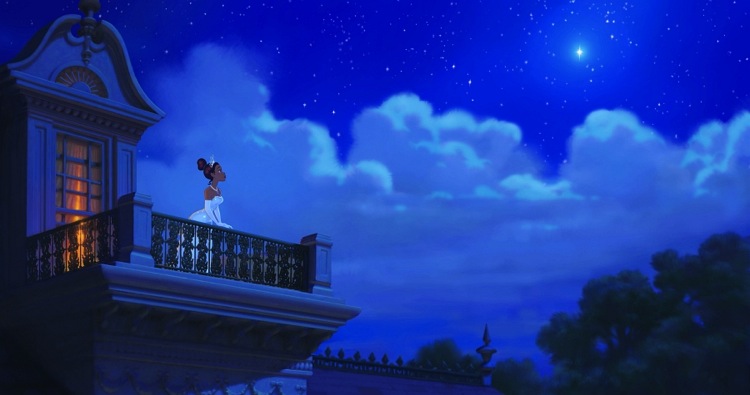
By David Ross. The Pixar-Disney partnership, about which I was initially skeptical, now seems all to the good. Pixar remains exuberantly creative, while Disney has absorbed some of the lessons of Pixar, the most basic of which is that kids have better instincts as well as worse instincts, and that there is plenty of money to be made by appealing to the former. My recent discussion of kids movies made no mention of Disney’s The Princess and the Frog (2009) because I had not yet seen it, but my little family had a rollicking time with it last night. I would call it Disney’s best film since The Fox and the Hound (1981), the last film to exhibit something, if only a shadow, of the old charm and simplicity. Coming on the heels of Bolt (2008) – Disney’s most successful Pixar rip-off attempt – The Princess and the Frog seems to signal that Disney has finally found the light at the end of its long tunnel of malaise, incompetence, condescension, and small-mindedness, otherwise known as the Eisner era.
The Princess and the Frog offers plenty to like. Instead of rounding up celebs to phone in the usual tired voice work (v. Mel Gibson in Pocahontas and Demi Moore in The Hunchback), Disney put together a low-profile but vibrant cast led by Anika Noni Rose as Tiana and Jenifer Lewis as Mama Odie. The acting is focused and energetic throughout, giving the entire film an air of personality and emotional engagement that recalls the films of Disney’s golden age (Ed Wynn as the Mad Hatter, etc.). Meanwhile, Randy Newman’s soundtrack, a pastiche of New Orleans jazz and zydeco, lends the film what all recent Disney films have lacked: bounce. While it is not going to convince anyone to throw away their old Clifton Chenier records, the soundtrack is a lark, and a welcome reprieve from the pop-Broadway syrup that dominated Disney’s dark age. Continue reading DVD Review: The Princess and the Frog: The End of the Disney Dark Age?
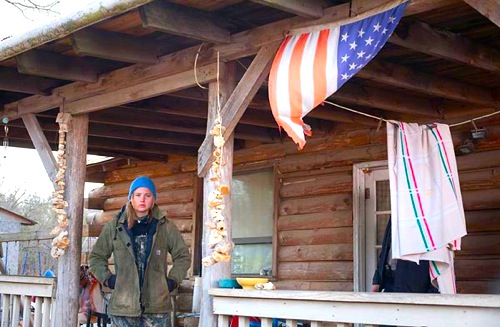
[LFM welcomes a new contributor today, Patricia Ducey, an LA-based screenwriter and film essayist whose work we’ve admired over the years. Her screenplay on Germany’s Baader-Meinhof gang was a finalist in the 2006 Liberty Film Festival screenplay contest. We’re glad to have her on board.]
By Patricia Ducey. Winter’s Bone (written by Debra Granik and Anne Rosellini, directed by Debra Granik; see the trailer here) garnered the Sundance Film Festival’s top award this year and received near universal critical praise, especially for young actress Jennifer Lawrence as the central character of Ree Dolly. Some have called Winter’s Bone a crime story, a western, a quest, or even a ‘country noir’—a definition that Daniel Woodrell, author of the original novel, might quibble with – but noir seems accurate enough. The film has a chilly atmosphere, shot in the relentless gray of winter, in perpetual twilight filtered through bare-limbed trees. We sense there are dark secrets in these hundred-year-old woods that are about to be disturbed.
The film introduces us to teenager Ree Dolly and her web of extended kin who eke out an existence in the Missouri Ozarks with a little ranching and a lot of ‘cookin’ (methamphetamine production). Ree is the sole provider for her two younger siblings and a nearly catatonic mother, since her father Jessup has run out on his bail bond when faced with a long stretch in prison for drug offenses. If Jessup doesn’t show up for his sentencing in one week’s time, the bondsman will take the ranch as collateral – and Ree and the family will be homeless.
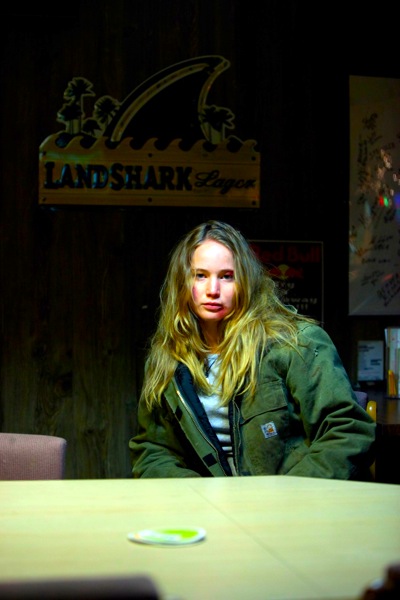
A cinematic set-up like this usually prompts an “uh-oh” for anyone hoping for more than another cringe-inducing anthropological foray into the backwoods. Kudos to writer/director Debra Granik, though, for taking pains to avoid the usual stereotypes of flyover country in several key aspects of the story, especially in Ree’s complex character.
Ree may be desperate for money, all right, but she reaches neither for the government teat nor for the family business of ‘cookin’ – the easiest ways to make a quick buck – because she does not see her or her family as victims of society entitled to an easy way out. Instead she sets out to find Jessup, dead or alive, and bring him back to justice. Ree has little but her own sense of honor and family duty to carry her, but that’s enough.
When Ree runs into the wall of silence from the local drug dealers (most of them are Dolly relations), she decides to enlist in the Army instead for the $40,000 bonus. The local Army recruiter, surprisingly, is presented as a sympathetic character: he probes her motives and actually talks her out of enlisting. He counsels Ree that she needs a better reason than the money to enlist, and it may be best to tend to her family for now. Watch closely for an early scene depicting the ROTC and the baby-tending classes at the high school. A PA announcement for college advising plays over the ‘two bad choices’ visual, indicating that the military here is a choice – not a dead end. Continue reading LFM Review: Winter’s Bone – It’s Safe to Go Back to the Art House